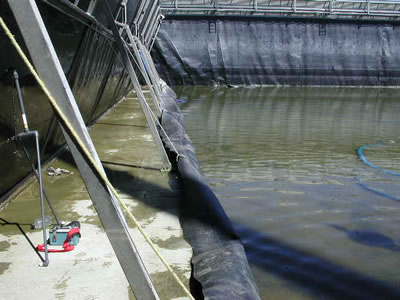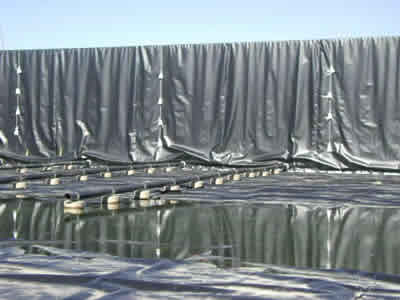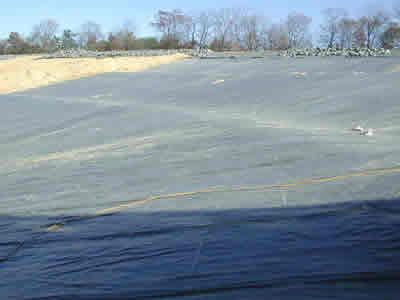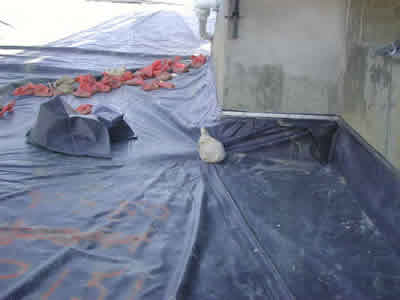As the need to perform liner integrity/leak location surveys is becoming more of a regulated requirement, it becomes more necessary to design lining systems so that single and primary liners of double lining systems can easily be surveyed. This requires advanced planning.
 |
| Cover soil/aggregate isolated from subgrade soil. |
There are four major boundary conditions that are required for the performance of effective surveys:
- A conductive medium above the geomembrane.
- A conductive medium through the holes in the geomembrane.
- A conductive medium immediately under the geomembrane.
- No connectivity between conductive media above and under the liner other than through the holes being sought.
The last is frequently negated in single liners by having cover soil in contact with subgrade soil around the periphery of the liner.
 |
| Concrete and metal structures complicate surveys. |
Related features to keep in mind include:
- Avoid batten strip fastenings
- Cover all concrete with liner where possible
- Avoid metal pipe penetrations
- Plan to cut channel to expose liner at the top of haul roads entering the cell
- Survey before placing cover soil over edge of liner
- Install an isolating flap between crest of slope and anchor trench
- Plan for wetting the cover soil during the survey
- Leak flow rate monitoring wells should be plastic so leaking water is not in contact with ground
- If wells are concrete, the plastic influent pipe should enter some way up from the floor
- On double lining systems cover soil and effluent/influent pipes may be in contact with subgrade soil provided the LDS is totally isolated from cover soil/subgrade
- A geocomposite between two geomembranes is not conductive (to avoid the need to backfill with water, use a GCL under the primary geomembrane, use a conductive geotextile on top of the geonet, or use a conductive primary geomembrane ensuring that that fusion welding breaks through the conductive layer so there will be no false positives at the edge of the flap, and that there are conductive strips across seams on the underside)
- In large facilities install current return electrodes under the liner as it is built
- Remove all sandbags and other impediments to a survey probe being dragged across a pond liner
- Use nonconductive tether lines for aerators or keep them out of the water
- Avoid pipe penetrations in sumps – use side slope riser pipes
- There needs to be a means of inserting a current return electrode in the secondary sump
- When using a water lance or the water puddle technique on exposed liner, the water must be retained on the top of the liner
- Concrete support columns in reservoirs should be booted all the way up to above water level
- Avoid underwater seals to concrete
- Avoid metal structures such as gratings
- On vertical walls of concrete basins, use concrete embedment liner rather than loose liner
 |
| Use concrete embedment (cast-in) liners on concrete walls rather than hanging loose sheet – the former has an assured conductive substrate. |
 |
| Metal flanges and pipe penetrations can be a problem but, depending on the size of leak, not impossible to deal with. |
 |
| Cover and and rip-rap should not be in contact with subgrade around the edge. |
 |
| Where possible, batten strips should be above maximum water line. |
There are many other details that could come to mind but the key is to remember the first four basic boundary conditions.
It is also extremely important to recognize that conventional design philosophy is that all single liners leak, so a drip or two coming out of the LDS is not a problem. A maximum allowable or Action Leakage Rate (ALR) should be specified and the LDS designed to handle that leakage rate without further damage to the lining system. For landfill bottom liners with a maximum 12 in. (300 mm) leachate head, the ALR is typically 20 gallons per acre.day (gpad) or 200 liters per hectare.day (lphd). For WWTP liners with 6 ft (2 m) of wastewater head it is typically 500 gpad (5000 lphd).
In summary, perform your electrical integrity survey at the completion of construction of the lining system, including soil cover if there is one, then repair the leaks that are found and the leak flow rate should be well within the ALR.











